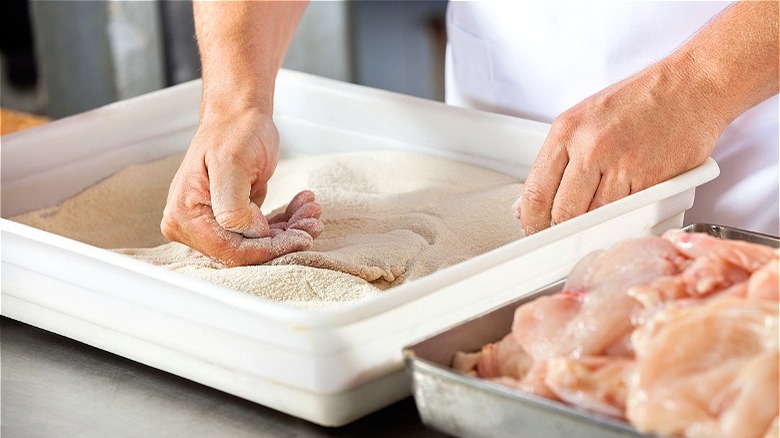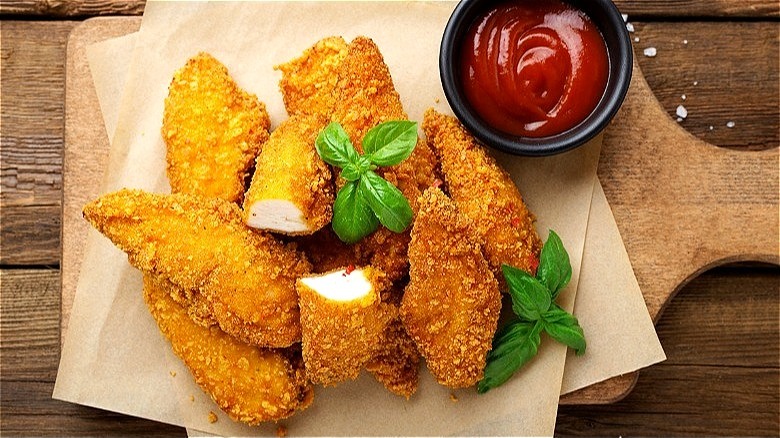What It Means To 'Dredge' In A Recipe
Anyone who decides to take up cooking as a new weekend hobby may initially feel overwhelmed by the somewhat alternate universe of language found in even the simplest of cookbooks. If your first introduction to the food world is watching professional chefs in high-paced stressful cooking situations, then you're familiar with the unknown dialect they all tend to use so casually, which has been deemed by the Michelin Guide as "restaurant lingo." Even the elementary act of dining out can lead you to uncover facts that cause you to doubt your food knowledge such as the feckless meaning behind the club sandwich.
When focusing exclusively on the kitchen, you may encounter a few confusing recipe terms and unknown foods as you delve into the cultivation of your culinary skills. Thankfully Better Homes & Gardens has an A to Z explanation guide of the trickier terms. Knowing what crème fraîche and haricots verts actually are is always helpful, but the process gets even more convoluted when you can't understand what a recipe is instructing you to do.
BBC Good Food has already helped you uncover the meaning of deglazing and perhaps you've done your own research in regard to emulsification. Yet what about some of the more basic terms? If a recipe casually instructs you to "dredge" food, are you breading it?
The specificities of 'dredging'
Have you ever used a word carelessly for years and then realized you've been using it all wrong? That happens to everyone from time to time. We're all guilty of using words synonymously with others when in actuality, they deserve their own place in our own mental vocabulary banks.
"Dredging" might be one of those terms since there's a good chance you already know what the word means, but do you know the exceptions? When you attempt to fry food at home, you probably use "breading" and "dredging" interchangeably, but they actually have two distinct definitions. While Cuisine at Home defines breading as a three-step process involving both dry and wet ingredients, The Culinary Pro defines dredging as tossing food in a light layer of flour or other coatings without the additional steps involving wet ingredients.
According to Better Homes & Gardens, dredging is simply the vehicle that gets you one step closer to perfectly battered foods. Simply add your desired coating to a shallow pan or plate and steep your food of choice in and around the coating, making sure to shake off any extra so the coating is nice and even, and go from there. Now that you what dredging actually means, how do you use this technique to make perfectly battered foods?
How dredging helps create an ideal texture
If you're wondering why you should dredge some of your favorite foods, Better Homes & Gardens claims this technique helps create a nice crunch to your meals. Additionally, dredged foods are usually cooked in a solid amount of butter or oil, so the odds are in your favor when it comes to whipping up some tasty creations. Beyond the extra texture that dredging provides if meat's on the menu, Beginner Food reminds you to remove any moisture from your food: wet coating can often prevent the desired browning that dredged food and hot oil often bring. Dredging also protects your food from high heat, which keeps your meat moist and tender.
While you can certainly dredge foods without including the extra steps necessary to bread, if you're after a crispy pan-fried chicken, for example, dredging can be seen as a crucial step in getting you one step closer to all that crunchy deliciousness. Since breading and dredging are two different techniques, they often work together to create some classic food favorites. Breaded foods are often dredged not once but twice, in between a dip in some raw eggs and milk (via Better Homes & Gardens). If you're looking to add another texture component to your favorite foods, whether used alone or in tandem with other techniques, you now have "dredging" successfully added to your list of essential culinary terms.


